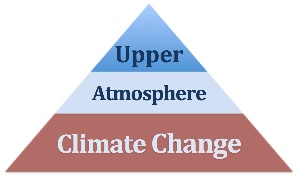- Created by Shun-Rong Zhang, last modified on Oct 13, 2016 13:02


Project Summary
Project Summary
for further information and collaboration, please contact
Shunrong Zhang ♦ MIT Haystack Observatory ♦ shunrong ((at)) mit dot edu. ◊ or any of the team members
Climate change is characterized by global surface warming associated with the anthropogenic increase in greenhouse gas concentrations since the start of the industrial era. In the Earth’s upper atmosphere where many modern technologies reside, it is now recognized that a long-term cooling has been taking place over the past several solar cycles. Compelling evidence for such cooling comes from direct measurements of the thermospheric density and the ionospheric temperature. A lot more indirect evidence has become available since the 1990s following a seminal modeling study by Roble and Dickinson (1989), suggesting potential effects of increased greenhouse gases on the ionosphere and thermosphere. However, there are several outstanding issues, for example, (1) the very strong ionospheric cooling observed by multiple ionospheric radars that does not fit with the prevailing theory based on the argument of anthropogenic greenhouse gas increases; (2) CO2 trends in the mesopause region observed by satellite missions are about twice of what current general circulation models predict; (3) trends in atmospheric wave activity and their impacts on the atmosphere-ionosphere system are poorly known and unquantified. Our international team will be taking on these challenging outstanding topics as our research theme, with the goal to improve the understanding of the long-term trends in the ionosphere and thermosphere.
Three main research focuses are (1) characterizing long-term trends with observations from in-situ and ground-based remote sensing instruments by summarizing and reviewing existing ionospheric and thermospheric results; (2) understanding the various driving mechanisms and identifying those that can consistently account for key observations; (3) evaluating the societal impacts of climate changes in the upper atmosphere. The research focus area (2) is the center of our effort. We plan to examine drivers from below and above, including (i) greenhouse gas effects with more accurate CO2 observational data and state-of-the-art models, (ii) potential lower atmosphere wave activity effects originating from global climate change, (iii) impact of secular changes of solar and magnetic activity, and (iv) effects of secular Earth magnetic field changes.
The outcome from this coordinated research effort includes publications and papers that provide comprehensive reviews of the long-term change pattern in the upper atmosphere, and highlight significantly improved understanding of the relative roles of major contributing factors to the observed trends. In particular, we anticipate new insights and will strive to reasonable scientific consensus regarding some important observational puzzles leading to new discoveries.
The team consists of scientists from 7 different countries actively working in the area of upper atmospheric climate change from various perspectives, covering satellite and ground-based observations from the lower to upper atmosphere, modeling and simulation, and ionosphere-thermosphere coupling.
The team members will meet for 2 one-week meetings, the May 2017 meeting at ISSI and the May 2018 meeting at ISSI-BJ.
- No labels